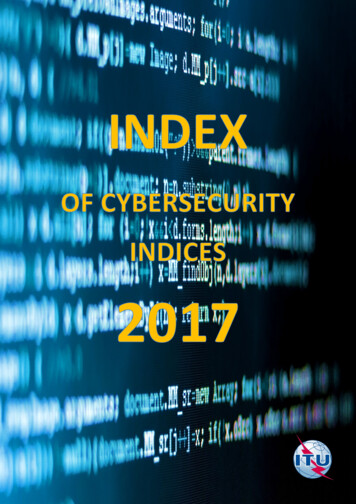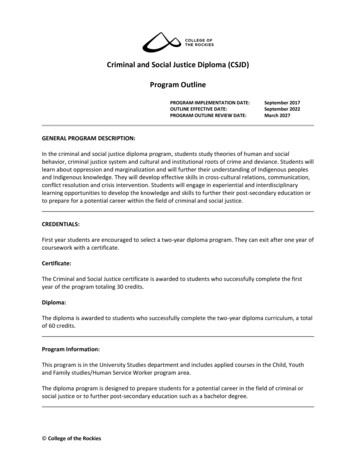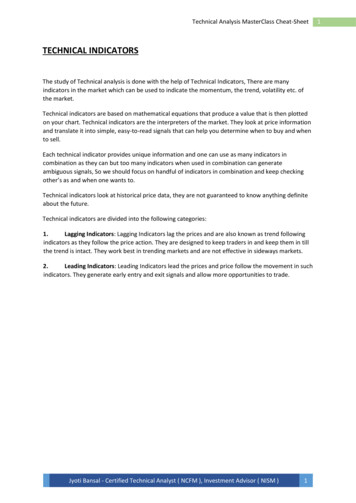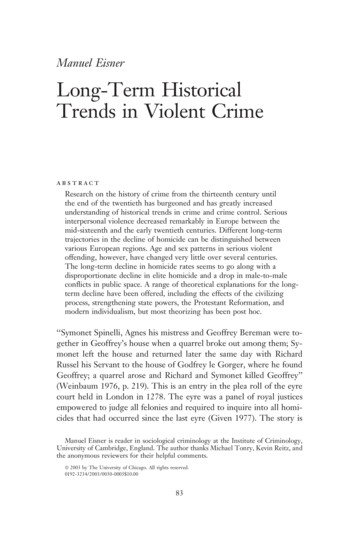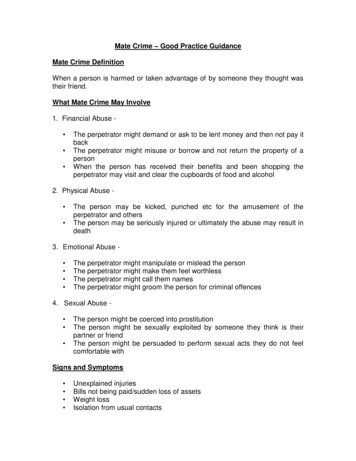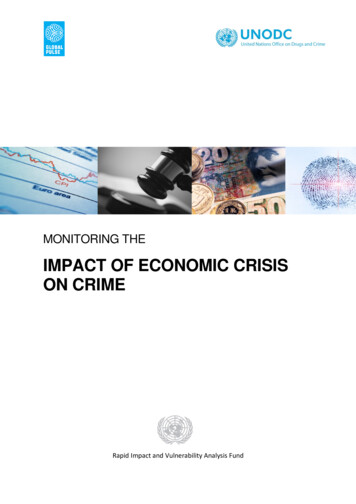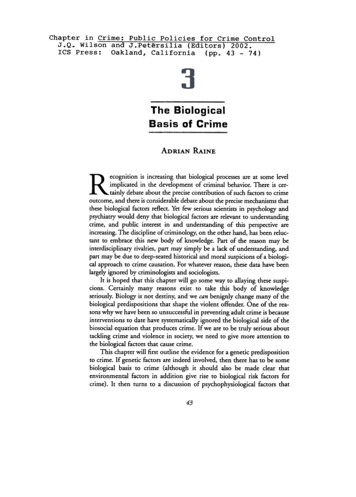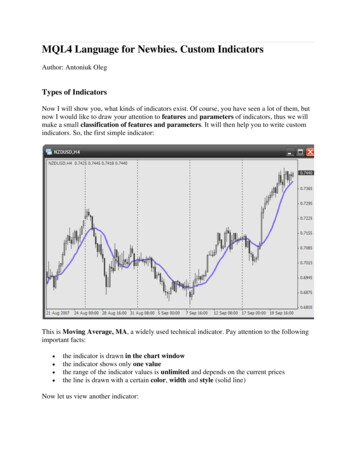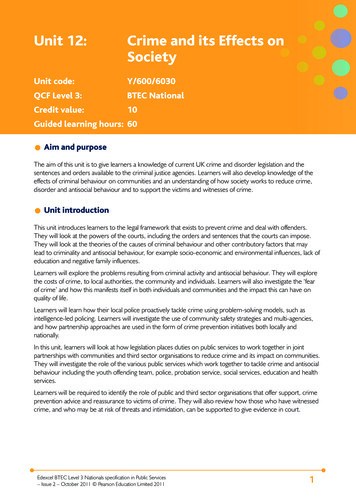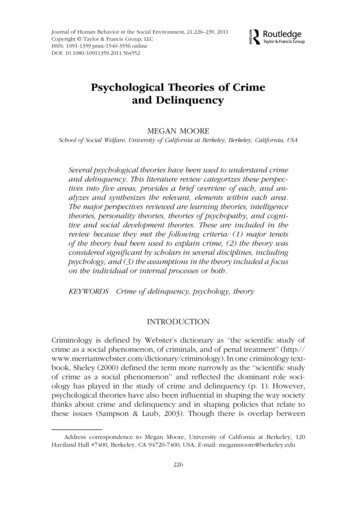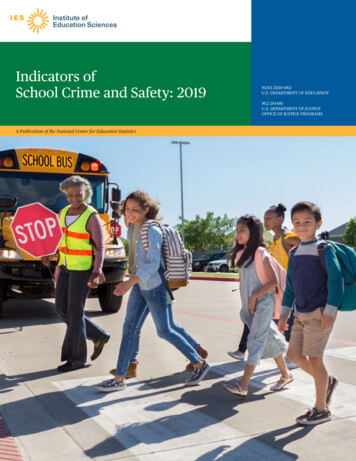
Transcription
Indicators ofSchool Crime and Safety: 2019A Publication of the National Center for Education StatisticsNCES 2020-063U.S. DEPARTMENT OF EDUCATIONNCJ 254485U.S. DEPARTMENT OF JUSTICEOFFICE OF JUSTICE PROGRAMS
Indicators ofSchool Crime and Safety: 2019JULY 2020Ke WangYongqiu ChenJizhi ZhangAmerican Institutes for ResearchBarbara A. OudekerkBureau of Justice StatisticsNCES 2020-063NCJ 254485U.S. DEPARTMENT OF EDUCATIONU.S. DEPARTMENT OF JUSTICE OFFICE OF JUSTICE PROGRAMS
U.S. Department of EducationBetsy DeVosSecretaryInstitute of Education SciencesMark SchneiderDirectorNational Center for Education StatisticsJames L. WoodworthCommissionerBureau of Justice StatisticsJeffrey H. AndersonDirectorThe National Center for Education Statistics (NCES) is the primary federal entity for collecting, analyzing,and reporting data related to education in the United States and other nations. It fulfills a congressionalmandate to collect, collate, analyze, and report full and complete statistics on the condition of education inthe United States; conduct and publish reports and specialized analyses of the meaning and significance ofsuch statistics; assist state and local education agencies in improving their statistical systems; and review andreport on education activities in foreign countries.The Bureau of Justice Statistics (BJS) is the primary federal entity for collecting, analyzing, publishing, anddisseminating statistical information about crime, its perpetrators and victims, and the operation of thejustice system at all levels of government. It fulfills a congressional mandate to provide valid statistics on crimeand justice systems, support improvement to justice information systems, and participate with national andinternational organizations to develop and recommend national standards for justice statistics.We strive to make our products available in a variety of formats and in language that is appropriate to a varietyof audiences. You, as our customer, are the best judge of our success in communicating information effectively.If you have any comments or suggestions about this product, we would like to hear from you. Please directyour comments toNCES, IES, U.S. Department of EducationPotomac Center Plaza550 12th Street SWWashington, DC 20202July 2020This report was prepared for the National Center for Education Statistics under Contract No. ED-IES12-D-0002 with American Institutes for Research. Mention of trade names, commercial products, ororganizations does not imply endorsement by the U.S. Government.Suggested CitationWang, K., Chen, Y., Zhang, J., and Oudekerk, B.A. (2020). Indicators of School Crime and Safety:2019 (NCES 2020-063/NCJ 254485). National Center for Education Statistics, U.S. Department ofEducation, and Bureau of Justice Statistics, Office of Justice Programs, U.S. Department of Justice.Washington, DC.This publication is only available online and is released primarily as a web-based report. To browse the contentsof the report, go to .asp. To download, view, and print theentire report as a PDF file, go to https://nces.ed.gov or https://bjs.gov.Contact at NCESCristobal de Brey202-245-8419Cristobal.DeBrey@ed.govContact at BJSBarbara A. Oudekerk202-616-3904Barbara.A.Oudekerk@usdoj.gov
Executive SummaryIntroductionOur nation’s schools should be safe havens forteaching and learning, free of crime and violence. Anyinstance of crime or violence at school not only affectsthe individuals involved but also may disrupt theeducational process and affect bystanders, the schoolitself, and the surrounding community (Brookmeyer,Fanti, and Henrich 2006; Goldstein, Young, andBoyd 2008).Establishing reliable indicators of the current stateof school crime and safety across the nation andregularly updating and monitoring these indicatorsare important in ensuring the safety of our nation’sstudents. This is the aim of Indicators of School Crimeand Safety.This report is the 22nd in a series of annualpublications produced jointly by the NationalCenter for Education Statistics (NCES), Institute ofEducation Sciences (IES), in the U.S. Department ofEducation, and the Bureau of Justice Statistics (BJS)in the U.S. Department of Justice. This report isreleased primarily as a web-based report, and contentsof the report can be viewed at .asp. This reportpresents the most recent data available on school crimeand student safety. The indicators in this report arebased on information drawn from a variety of datasources, including national and international surveysof students, teachers, principals, and postsecondaryinstitutions. Sources include results from the SchoolAssociated Violent Death Surveillance System,sponsored by the U.S. Department of Education,the U.S. Department of Justice, and the Centers forDisease Control and Prevention (CDC); the NationalVital Statistics System, sponsored by CDC; theK-12 School Shooting Database, sponsored by theU.S. Department of Defense; the National CrimeVictimization Survey and School Crime Supplement tothat survey, sponsored by BJS and NCES, respectively;the Youth Risk Behavior Survey, sponsored by CDC;the School Survey on Crime and Safety, Fast ResponseSurvey System, EDFacts, and Early ChildhoodLongitudinal Study, Kindergarten Class of 2010–11,all sponsored by NCES; the Teaching and LearningInternational Survey, sponsored by the Organizationfor Economic Cooperation and Development; andthe Campus Safety and Security Survey, sponsoredby the U.S. Department of Education. The mostrecent data collection for each indicator varied bysurvey, from 2016 to 2019. Each data source has anindependent sample design, data collection method,and questionnaire design, or is the result of a universedata collection. Findings described in this report withcomparative language (e.g., higher, lower, increase,and decrease) are statistically significant at the.05 level. Additional information about methodologyand the datasets analyzed in this report may be foundin appendix A.This report covers topics such as victimization,bullying and electronic bullying, school conditions,fights, weapons, availability and student use of drugsand alcohol, student perceptions of personal safetyat school, and criminal incidents at postsecondaryinstitutions. Indicators of crime and safety arecompared across different population subgroups andover time. Data on crimes that occur away from schoolare offered as a point of comparison where available.Key FindingsPreliminary data show that there were 42 schoolassociated violent deaths 1 from July 1, 2016,through June 30, 2017 (Indicator 1). In 2018,among students ages 12–18, there were about836,100 total victimizations (theft2 and nonfatalviolent victimization 3) at school 4 and 410,200victimizations away from school (Indicator 2). Duringthe 2017–18 school year, 35 percent of public schools(28,700 schools) took at least one serious disciplinaryaction for specific offenses (Indicator 18). Of the958 total hate crimes reported on college campusesin 2017, the most common type of hate crime was1A school-associated violent death is defined as a homicide, suicide,or legal intervention death (involving a law enforcement officer),in which the fatal injury occurred on the campus of a functioningelementary or secondary school in the United States, while thevictim was on the way to or from regular sessions at school, or whilethe victim was attending or traveling to or from an official schoolsponsored event. Victims may include not only students and staffmembers, but also others at school, such as students’ parents andcommunity members.2“Theft” includes attempted and completed purse-snatching,completed pickpocketing, and all attempted and completed thefts,with the exception of motor vehicle thefts. Theft does not includerobbery, which involves the threat or use of force and is classified asa violent crime.3“Violent victimization” includes rape, sexual assault, robbery,aggravated assault, and simple assault.4“At school” includes in the school building, on school property,and on the way to or from school.Indicators of School Crime and Safety: 2019iii
destruction, damage, and vandalism (437 incidents),followed by intimidation (385 incidents) and simpleassault (83 incidents; Indicator 22). In spring 2016, crime in the neighborhood andselling or using drugs or excessive drinking inpublic were the two most commonly reportedschool neighborhood problems. Based onschool administrator reports, 34 percent offifth-graders attended schools where crime inthe neighborhood was a problem, 31 percentattended schools where selling or using drugsor excessive drinking in public was a problem,25 percent attended schools with violencein the neighborhood, 17 percent attendedschools with gangs in the neighborhood, and16 percent attended schools with tensions basedon racial, ethnic, or religious differences in theneighborhood. For all five school neighborhoodproblems reported by school administrators, fifthgraders attending schools where these were a bigproblem or somewhat of a problem consistentlyhad lower scores in reading, mathematics, andscience than did those attending schools wherethese were not a problem (Spotlight 2). A total of 42 student, staff, and nonstudentschool-associated violent deaths occurredbetween July 1, 2016, and June 30, 2017, whichincluded 28 homicides, 13 suicides, and 1 legalintervention death5 (Indicator 1). Between July 1, 2016, and June 30, 2017, a totalof 18 of the 1,587 homicides of school-age youth(ages 5–18) occurred at school.6 During the sameperiod, 6 of the 2,186 total suicides of school-ageyouth occurred at school (Indicator 1). In school year 2018–19, there were 66 reportedschool shootings7 with casualties at public andprivate elementary and secondary schools,including 29 school shootings with deathsand 37 school shootings with injuries only(Indicator 1). In 2018, students ages 12–18 experienced836,100 total victimizations (i.e., thefts andThe following key findings are drawn from brand newindicators in this edition of the report (Spotlights 1 and2 and Indicator 11) as well as from indicators withupdated data (Indicators 1, 2, 6, 7, 18, 19, 21, and 22). During the 2017–18 school year, about 51 percentof public schools (or 42,200 schools) reportedproviding diagnostic mental health assessmentsto evaluate students for mental health disorders.Approximately 38 percent of public schools (or31,500 schools) reported providing treatment tostudents for mental health disorders (Spotlight 1). During the 2017–18 school year, 52 percent ofpublic schools reported that inadequate fundingwas a major limitation in their efforts to providemental health services to students; 41 percentreported that inadequate access to licensedmental health professionals was a major limitation(Spotlight 1). ivDuring the 2017–18 school year, the percentageof public schools reporting that inadequateaccess to licensed mental health professionalswas a major limitation in their efforts to providemental health services to students was higher fortraditional public schools (41 percent) than forpublic charter schools (28 percent; Spotlight 1).In spring 2016, physical conflicts amongstudents and student bullying were the twomost commonly reported school problems.Based school administrator reports, 25 percentof fifth-graders attended schools where physicalconflicts among students occurred at least oncea month, 24 percent attended schools wherestudent bullying occurred at least once a month,5 percent attended schools where theft occurredat least once a month, 5 percent attended schoolswhere widespread disorder in classrooms occurredat least once a month, and 4 percent attendedschools where vandalism of school propertyoccurred at least once a month. Fifth-graderswhose school administrators reported thatcertain school problems occurred at least oncea month generally had lower scores in reading,mathematics, and science than did those whoseschool administrators reported that the problemnever occurred (Spotlight 2).Executive Summary5A legal intervention death is defined as a death caused by a lawenforcement agent in the course of arresting or attempting to arresta lawbreaker, suppressing a disturbance, maintaining order, orengaging in another legal action.6This finding is drawn from the School-Associated Violent DeathSurveillance System, which defines deaths “at school” as those thatoccur on the property of a functioning elementary or secondaryschool, on the way to or from regular sessions at school, or whileattending or traveling to or from a school-sponsored event.7“School shootings” include all incidents in which a gun isbrandished or fired on school property or a bullet hits schoolproperty for any reason, regardless of the number of victims, time ofday, or day of the week. (An instance of threatening or attemptingto shoot can be included even if no shots were fired.)
nonfatal violent victimizations) at school and410,200 total victimizations away from school.8These figures represent total victimization ratesof 33 victimizations per 1,000 students at school,compared with 16 victimizations per 1,000students away from school (Indicator 2). From 1992 to 2018, the total victimizationrate and the rates of specific crimes—thefts andviolent victimizations—declined for studentsages 12–18, both at school and away from school(Indicator 2). During the 2017–18 school year, 80 percentof public schools recorded that one or moreincidents of violence,9 theft, or other crimes10 hadtaken place, amounting to 1.4 million incidents.During the same year, 47 percent of schoolsreported one or more incidents to the police,amounting to 422,800 incidents (Indicator 6). The percentages of public schools that recordedone or more incidents of violence, theft, orother crimes and that reported such incidents tothe police were lower in 2017–18 than in everysurvey year between 1999–2000 and 2009–10.However, the percentage of schools that recordedserious violent incidents was higher in 2017–18than in 2015–16 (21 vs. 15 percent; Indicator 6). The percentage of public schools that reportedstudent bullying occurred at least once a weekdecreased from 29 percent in 1999–2000 to14 percent in 2017–18 (Indicator 7). In 2017–18, about 15 percent of public schoolsreported that cyberbullying had occurred amongstudents at least once a week at school or awayfrom school in 2017–18. Nine percent of publicschools also reported that the school environmentwas affected by cyberbullying, and 8 percent ofschools reported that staff resources were used todeal with cyberbullying (Indicator 7).8“Students” refers to youth ages 12–18 whose educationalattainment did not exceed grade 12 at the time of the survey. Anuncertain percentage of these persons may not have attended schoolduring the survey reference period. These data do not take intoaccount the number of hours that students spend at school or awayfrom school.9“Violent incidents” include rape, sexual assault other than rape,physical attack or fight with or without a weapon, threat of physicalattack with or without a weapon, and robbery with or without aweapon.10“Other incidents” include possession of a firearm or explosivedevice; possession of a knife or sharp object; distribution, possession,or use of illegal drugs or alcohol; inappropriate distribution,possession, or use of prescription drugs; and vandalism. In 2018, some 93 percent of lower secondaryteachers in U.S. public schools reported that theywere able to make expectations about studentbehavior clear quite a bit or a lot, 88 percentreported that they were able to get studentsto follow classroom rules quite a bit or a lot,85 percent reported that they were able to controldisruptive behavior in the classroom quite a bitor a lot, and 80 percent reported that they wereable to calm a student who is disruptive or noisyquite a bit or a lot. These percentages were notmeasurably different from the respective OECDaverages (Indicator 11). Among lower secondary teachers in publicschools in the United States, lower percentagesof teachers with less than 3 years of teachingexperience than of teachers with more yearsof teaching experience, in general, reportedbeing able to manage various aspects of studentbehavior quite a bit or a lot (Indicator 11). During the 2017–18 school year, 35 percentof public schools (28,700 schools) took at leastone serious disciplinary action—including outof-school suspensions lasting 5 or more days,removals with no services for the remainder of theschool year, and transfers to specialized schools—for specific offenses (Indicator 18). The percentage of public schools taking at least oneserious disciplinary action was lower in 2017–18than in 2003–04 across all specific offense typesexcept the distribution, possession, or use ofalcohol, for which there was no measurabledifference between the two years (Indicator 18). The percentage of public schools reporting theuse of security cameras to monitor the schoolincreased from 19 percent in 1999–2000 to83 percent in 2017–18 (Indicator 19). The percentage of public schools that hada written plan in place for procedures to beperformed in the event of an active shooterincreased over time, from 79 percent in 2003–04to 92 percent in 2017–18 (Indicator 19). The percentage of public schools that reportedhaving one or more security staff present at schoolat least once a week increased from 42 percent in2005–06 to 61 percent in 2017–18. In 2017–18,greater percentages of high schools (84 percent)Indicators of School Crime and Safety: 2019v
and middle schools (80 percent) reported havingany security staff, compared with primary schools(51 percent; Indicator 19).vi In 2017, about 28,900 criminal incidentson campuses at postsecondary institutionswere reported to police and security agencies,representing a 2 percent increase from 2016,when 28,400 criminal incidents were reported.The number of on-campus crimes reportedper 10,000 full-time-equivalent students alsoincreased, from 19.3 in 2016 to 19.6 in 2017(Indicator 21). The number of on-campus crimes reportedin 2017 was lower than the number reportedin 2001 for every category except forcible sexoffenses, murder, and negligent manslaughter.Executive SummaryThe number of reported forcible sex offenses oncampus increased from 2,200 in 2001 to 10,400in 2017 (a 372 percent increase; Indicator 21). In 2017, out of the 958 total hate crimesreported on college campuses, the most commontype of hate crime was destruction, damage,and vandalism (437 incidents), followed byintimidation (385 incidents) and simple assault(83 incidents). These were also the three mostcommon types of hate crimes reported byinstitutions from 2010 to 2016 (Indicator 22). Race, religion, and sexual orientation were thecategories of motivating bias most frequentlyassociated with hate crimes at postsecondaryinstitutions in 2017 (Indicator 22).
ForewordIndicators of School Crime and Safety: 2019 provides themost recent national indicators on school crime andsafety. The information presented in this report servesas a reference for policymakers and practitioners sothat they can develop effective programs and policiesaimed at violence and school crime prevention.Accurate information about the nature, extent, andscope of the problem being addressed is essential fordeveloping effective programs and policies.This is the 22nd edition of Indicators of School Crimeand Safety, a joint publication of the Bureau of JusticeStatistics (BJS) and the National Center for EducationStatistics (NCES). This report provides detailedstatistics to inform the nation about current aspectsof crime and safety in schools.The 2019 edition of Indicators of School Crimeand Safety includes the most recent available data,compiled from a number of statistical data sourcessupported by the federal government. Such sourcesinclude results from the School-Associated ViolentDeath Surveillance System, sponsored by the U.S.Department of Education, the U.S. Departmentof Justice, and the Centers for Disease Control andPrevention (CDC); the National Vital StatisticsSystem, sponsored by CDC; the K-12 School ShootingDatabase, sponsored by the U.S. Department ofDefense; the National Crime Victimization Surveyand School Crime Supplement to that survey,sponsored by BJS and NCES, respectively; the YouthRisk Behavior Survey, sponsored by CDC; the SchoolSurvey on Crime and Safety, Fast Response SurveySystem, EDFacts, and Early Childhood LongitudinalStudy, Kindergarten Class of 2010–11, all sponsoredby NCES; the Teaching and Learning InternationalSurvey, sponsored by the Organization for EconomicCooperation and Development; and the CampusSafety and Security Survey, sponsored by the U.S.Department of Education.This report is released primarily as a web-based report,and contents of the report can be viewed at .asp.BJS and NCES continue to work together in orderto provide timely and complete data on the issues ofschool-related violence and safety.James L. WoodworthCommissionerNational Center for Education StatisticsJeffrey H. AndersonDirectorBureau of Justice StatisticsIndicators of School Crime and Safety: 2019vii
AcknowledgmentsThe authors are grateful to the sponsoring agencies,the National Center for Education Statistics (NCES)and the Bureau of Justice Statistics (BJS), forsupporting this report.From BJS, we wish to thank Allen Beck, DevonAdams, Doris James, Heather Brotsos, EricHendrixson, and Jill Thomas, who served asreviewers, and Rachel Morgan, who verified data fromthe National Crime Victimization Survey. Outsideof NCES and BJS, Nancy Brener, Mark Anderson,viiiAcknowledgmentsJeffrey Hall, and Kristin Holland of the Centers forDisease Control and Prevention generously provideddata and performed a review of data documentation.We also value the review of this report and thecontinued support provided by the Office of Safe andHealthy Students.The authors would like to thank the many individualswho completed the survey instruments that makethis report possible. This report would not have beenpossible without their cooperation.
ContentsExecutive Summary . iiiForeword . viiAcknowledgments . viiiList of Tables . xList of Figures .xvIntroduction . 1Spotlights . 6Spotlight 1: Prevalence of Mental Health Services Provided by Public Schools and Limitations inSchools’ Efforts to Provide Mental Health Services .7Spotlight 2: School and School Neighborhood Problems .14Violent Deaths . 24Indicator 1: Violent Deaths at School and Away From School and School Shootings . 25Nonfatal Student and Teacher Victimization . 28Indicator 2: Incidence of Victimization at School and Away From School . 29Indicator 3: Prevalence of Victimization at School . 34Indicator 4: Threats and Injuries With Weapons on School Property . 38Indicator 5: Teachers Threatened With Injury or Physically Attacked by Students .[Web-only]School Environment . 42Indicator 6: Violent and Other Criminal Incidents Recorded by Public Schools and ThoseReported to the Police .43Indicator 7: Discipline Problems Reported by Public Schools . 48Indicator 8: Students’ Reports of Gangs at School . 53Indicator 9: Students’ Reports of Hate-Related Words and Hate-Related Graffiti and Schools’Reports of Hate Crimes .55Indicator 10: Bullying at School and Electronic Bullying . 59Indicator 11: Teachers’ Reports on Managing Classroom Behaviors . 66Fights, Weapons, and Illegal Substances . 69Indicator 12: Physical Fights on School Property and Anywhere . 70Indicator 13: Students Carrying Weapons on School Property and Anywhere and Students’Access to Firearms .74Indicator 14: Students’ Use of Alcohol . 78Indicator 15: Marijuana Use and Illegal Drug Availability . 82Fear and Avoidance . 86Indicator 16: Students’ Perceptions of Personal Safety at School and Away From School . 87Indicator 17: Students’ Reports of Avoiding School Activities or Classes or Specific Places in School . 90Discipline, Safety, and Security Practices . 93Indicator 18: Serious Disciplinary Actions Taken by Public Schools . 94Indicator 19: Safety and Security Practices at Public Schools . 98Indicator 20: Students’ Reports of Safety and Security Measures Observed at School . 107Postsecondary Campus Safety and Security . 109Indicator 21: Criminal Incidents at Postsecondary Institutions . 110Indicator 22: Hate Crime Incidents at Postsecondary Institutions . 114References . 117Supplemental Tables . 121Appendix A: Technical Notes . 209Appendix B: Glossary of Terms . 225Indicators of School Crime and Safety: 2019ix
List of TablesTableA.PageNationally representative sample and universe surveys used in this report .5S1.1. Number and percentage of public schools providing diagnostic mental health assessments andtreatment to students and, among schools providing these services, percentage providing themat school and outside of school, by selected school characteristics: 2017–18 . 122S1.2. Percentage of public schools reporting that various factors limited in a major way their effortsto provide mental health services to students, by selected school characteristics: 2017–18 . 123S2.1. Percentage of fall 2010 first-time kindergartners whose school adminstrator in fifth gradereported that selected problems occurred at the school at least once a month or were a problemin the school’s neighborhood, by selected child, family, and school characteristics in spring offifth grade: Spring 2016 . 124S2.2. Percentage distribution of fall 2010 first-time kindergartners in spring of fifth grade andfifth-grade scores on and standard deviations of various academic, social, and emotional scales,by frequency or extent of selected school or neighborhood problems reported by the schooladministrator: Spring 2016 . 125S2.3. Percentage of fall 2010 first-time kinde
entire report as a PDF file, go to . https://nces.ed.gov or https://bjs.gov. Contact at NCES. Cristobal de Brey. 202-245-8419. Cristobal.DeBrey@ed.gov. Contact at BJS. Barbara A. Oudekerk. . 958 total hate crimes reported on college campuses in 2017, the most common type of hate crime was . 1 . A school-associated violent death is defined as .
